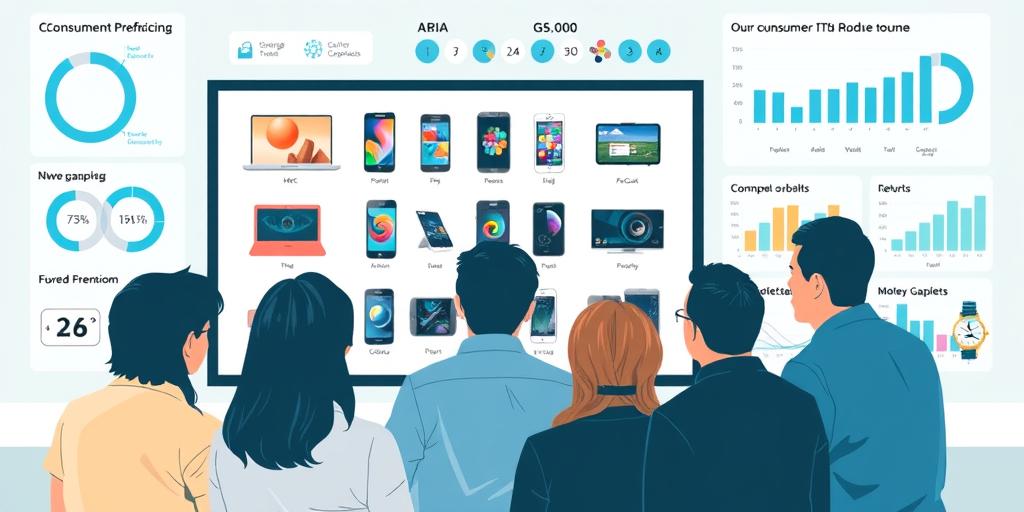The Gadget Industry is a dynamic and ever-evolving sector driven by consumer preferences. Understanding these preferences is crucial for brands to thrive in this competitive market. From analyzing the latest gadget trends to understanding the factors that influence purchase decisions, businesses need to stay ahead of the curve to capture the attention of tech-savvy consumers.
Understanding Consumer Preferences in the Gadget Industry
The Gadget Industry is witnessing a rapid shift in consumer behavior, with evolving needs and preferences shaping the landscape of gadget consumption.
The Evolving Landscape of Gadget Consumption
Consumers today are more discerning than ever before when it comes to their gadgets. They are seeking devices that are not only functional but also aesthetically pleasing, sustainable, and offer a seamless user experience. The rise of social media and online reviews has further amplified the importance of brand reputation and customer satisfaction.
Key Factors Influencing Gadget Preferences
Several key factors play a pivotal role in influencing consumer preferences in the Gadget Industry.
Functionality and Features
Consumers prioritize gadgets that meet their specific needs and offer advanced features. For example, a smartphone user might prioritize camera quality, battery life, and processing power, while a gamer might focus on graphics capabilities and performance.
Design and Aesthetics
The aesthetic appeal of a gadget is increasingly important to consumers. They want devices that look sleek, modern, and complement their personal style. This is particularly evident in the popularity of minimalist designs and premium materials.
Brand Reputation and Trust
Consumers are more likely to choose a gadget from a brand they trust. This trust is built on factors such as brand history, customer reviews, and perceived quality.
Price and Value for Money
Price remains a significant factor in gadget purchase decisions. Consumers want to ensure they are getting good value for their money, considering the features, performance, and durability of the device.
Sustainability and Environmental Impact
There is a growing awareness among consumers regarding the environmental impact of their purchases. They are increasingly seeking gadgets that are made from recycled materials, have energy-efficient designs, and are built to last.
The Role of Technology and Innovation
Rapid advancements in technology and innovation are constantly shaping the Gadget Industry. New technologies, like artificial intelligence (AI) and augmented reality (AR), are creating exciting possibilities for innovative gadgets and enhancing consumer experiences.
Data-Driven Insights into Consumer Preferences
To effectively analyze consumer preferences in the Gadget Industry, businesses must leverage data-driven insights.
Market Research and Consumer Surveys
Conducting market research and consumer surveys is essential for gaining a deep understanding of consumer needs and preferences. This data can be used to identify emerging trends, assess the popularity of existing products, and gauge customer satisfaction.
Social Media Analytics and Sentiment Analysis
Social media platforms provide a wealth of data about consumer preferences. By analyzing social media posts, comments, and reviews, businesses can gauge public sentiment towards specific brands, products, and features.
Sales Data and Purchase Patterns
Analyzing sales data and purchase patterns can reveal valuable insights into consumer behavior. This data can help identify popular product categories, understand seasonal trends, and optimize pricing strategies.
Analyzing User Reviews and Feedback
User reviews and feedback provide valuable insights into the customer experience. By analyzing this data, businesses can identify areas for improvement, address customer concerns, and enhance product development.
Strategies for Targeting Consumer Preferences
Understanding consumer preferences is only the first step. Businesses need to develop strategies to effectively target these preferences.
Product Development and Innovation
To remain competitive, businesses must prioritize product development and innovation. This involves constantly exploring new technologies, incorporating customer feedback, and creating gadgets that meet evolving needs.
Marketing and Advertising Campaigns
Targeted marketing and advertising campaigns are crucial for reaching the right audience. Businesses need to understand their target demographic, their online and offline behaviors, and their preferred channels for receiving information.
Customer Relationship Management (CRM)
Building strong customer relationships is essential for long-term success in the Gadget Industry. Implementing a robust CRM system can help businesses personalize interactions, provide excellent customer service, and foster brand loyalty.
Personalized Recommendations and Content
Using data analytics, businesses can offer personalized recommendations and content to customers based on their preferences, purchase history, and browsing behavior. This can enhance the shopping experience and drive conversions.
Case Studies: Successful Gadget Brands
Several successful gadget brands have effectively tapped into consumer preferences to achieve remarkable success.
Apple: Innovation and Design Focus
Apple has built a strong reputation for innovation and design. Their products are known for their sleek aesthetics, user-friendly interfaces, and cutting-edge features. This focus on design and user experience has contributed to their enduring popularity.
Samsung: Wide Range of Options and Competitive Pricing
Samsung offers a wide range of products at various price points, catering to diverse consumer needs. Their products are known for their competitive pricing and advanced features. This strategy has allowed them to compete effectively in different market segments.
Xiaomi: Value for Money and Emerging Technologies
Xiaomi has gained popularity by offering high-quality gadgets at competitive prices. They are known for their focus on value for money and their willingness to adopt emerging technologies, such as AI and the Internet of Things (IoT).
Future Trends in Gadget Preferences
The Gadget Industry is constantly evolving, with several emerging trends shaping future consumer preferences.
Artificial Intelligence and Machine Learning
AI and machine learning are playing an increasingly important role in gadget development. Consumers are looking for devices that can learn their habits, offer personalized recommendations, and automate tasks.
Augmented and Virtual Reality
AR and VR are transforming the way we interact with technology. Consumers are eager to experience immersive gaming, interactive shopping experiences, and educational applications powered by these technologies.
Sustainable and Eco-Friendly Gadgets
Sustainability is becoming a key consideration for consumers. They are looking for gadgets that are made from recycled materials, have energy-efficient designs, and have a minimal environmental impact.
The Rise of Smart Homes and Connected Devices
The rise of smart homes and connected devices is driving demand for gadgets that can seamlessly integrate with other devices and systems. Consumers are looking for smart home solutions that offer convenience, comfort, and security.
Adapting to Evolving Consumer Preferences
The Gadget Industry is characterized by its dynamism and the need to adapt to constantly evolving consumer preferences.
Businesses need to prioritize continuous innovation and adaptation, building strong customer relationships based on trust and transparency. Leveraging data and analytics is crucial for informed decision-making, allowing brands to stay ahead of the curve and capture the attention of tech-savvy consumers. By understanding consumer preferences, responding to emerging trends, and delivering exceptional customer experiences, businesses in the Gadget Industry can achieve long-term success in this exciting and ever-changing market.




